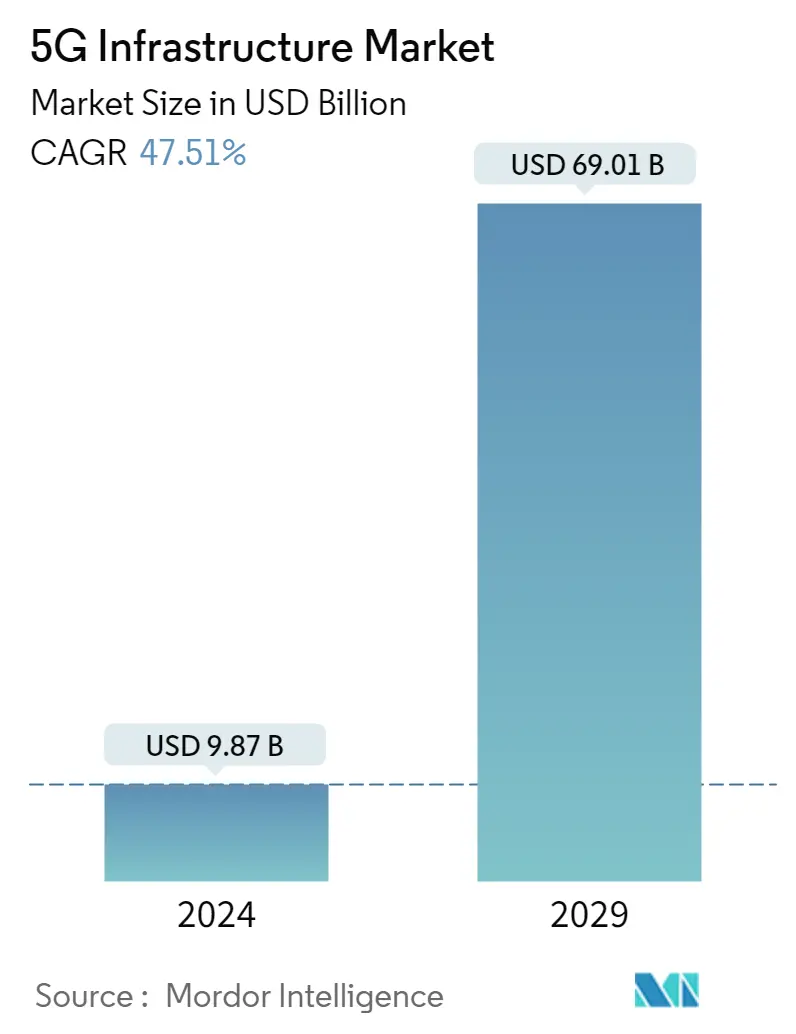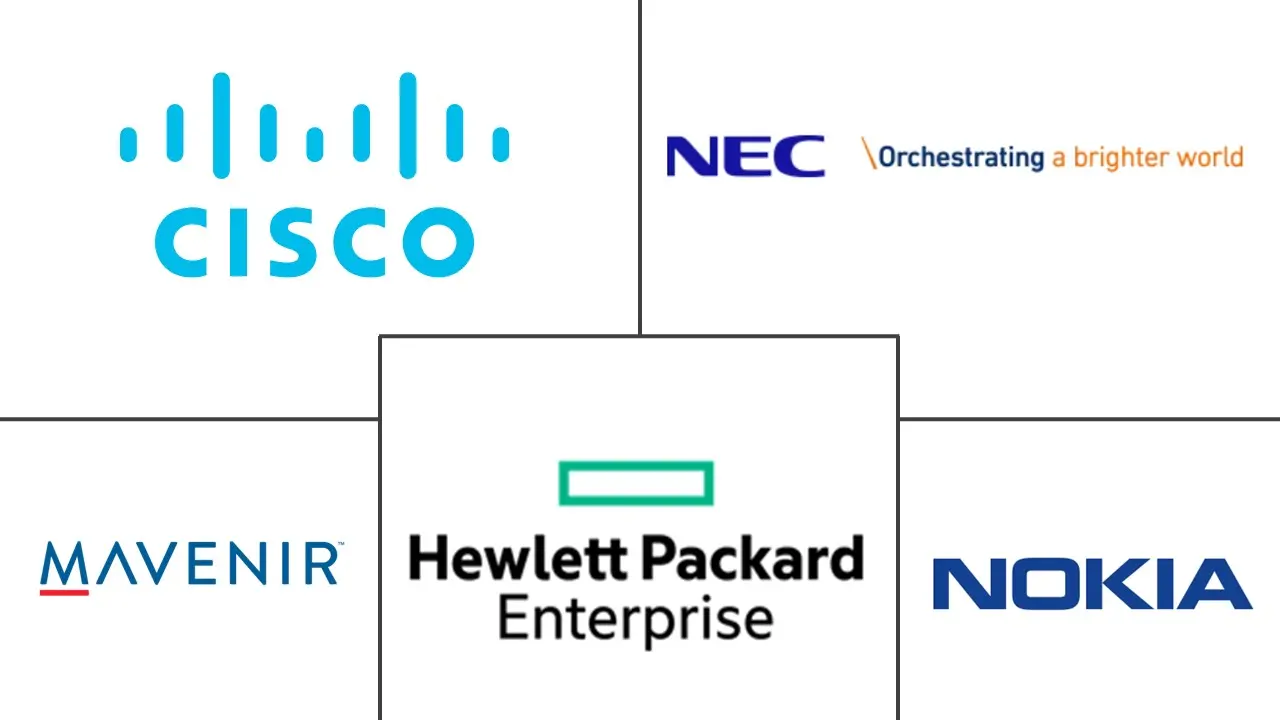Market Size of 5G Infrastructure Industry

| Study Period | 2019 - 2029 |
| Market Size (2024) | USD 9.87 Billion |
| Market Size (2029) | USD 69.01 Billion |
| CAGR (2024 - 2029) | 47.51 % |
| Fastest Growing Market | Asia Pacific |
| Largest Market | Asia Pacific |
Major Players
*Disclaimer: Major Players sorted in no particular order |
5G Infrastructure Market Analysis
The 5G Infrastructure Market size is estimated at USD 9.87 billion in 2024, and is expected to reach USD 69.01 billion by 2029, growing at a CAGR of 47.51% during the forecast period (2024-2029).
- The market is driven by government initiatives towards the deployment of 5G and advancement in new technologies like iot, smart cities, and many more, pushing the market players to develop new services/solutions to capture the market share.
- 5G technology offers a significantly lower latency rate, the delay between receiving and sending information. This decrease in end-to-end latency improves user experiences and creates new opportunities for innovative use cases. Also, there is a trend of Ultra-Reliable Low Latency Communications (URLLC), a subdivision of 5G network architecture that enables efficient scheduling of data transfers and caters to various advanced services across applications such as factory automation, the industrial internet, smart grid, autonomous driving, and or robotic surgeries. Hence, demand for lower latency rates among applications above is significantly boosting the growth of the global 5G infrastructure market.
- According to GSMA Intelligence Mobile Economy Report 2023, 5G will underpin future mobile innovation and services, building on ongoing deployments and adoption. 5G adoption will reach 17% this year, reaching 54% (equivalent to 5.3 billion connections) by 2030. The technology will add almost USD1 trillion to the global economy in 2030, spreading benefits across all industries. Such a huge rise in 5G adoption would drive the studied market.
- Further, in smart cities, 5G technology has the potential to enhance public security and safety significantly. Smart city systems can gather and analyze massive volumes of data from several sources, including video security cameras, intelligent traffic lights, and other iot devices, using the fast and responsive 5G network. For instance, Las Vegas is testing three pilot projects, with the government allocating USD 500 million to find ways to connect the entire city by 2025. The increase in the number of smart city projects undertaken by governments influences the demand for 5G infrastructure.
- The deployment of 5G networks requires significant infrastructure investments, including installing new base stations, small cells, and fiber optic cables. Compared to previous generations of cellular networks, 5G infrastructure deployment involves a denser network architecture due to its reliance on smaller cell sizes and increased network capacity. This densification increases the infrastructure requirements and overall capital expenditure, leading to high initial costs for network operators and service providers. This is expected to challenge the market's growth.
- Telecom operators expanded the offering of their 5G connection for several countries during the pandemic. For instance, in March 2021, Philippines-based Globe Telecom announced that it would accelerate its 5G Roaming rollout to other countries in the Middle East and Asia. Globe is set to open its 5G connection to visiting customers of Singtel of Singapore, CSL Hong Kong, and Ooredoo of Kuwait. In the post-pandemic era, the market is expected to grow further.
5G Infrastructure Industry Segmentation
The 5G infrastructure market is defined based on the revenues generated from the various communication infrastructure types that are used across the globe. The analysis is based on the market insights captured through secondary research and the primaries. The market also covers the major factors impacting the growth of the market in terms of drivers and restraints.
The study tracks the key market parameters, underlying growth influencers, and major vendors operating in the industry, which supports the market estimations and growth rates over the forecast period. The study also tracks the revenue accrued from the various communication infrastructure types that are being used across the globe. In addition, the study provides the global 5G infrastructure market trends, along with key vendor profiles. The study further analyses the overall impact of COVID-19 on the ecosystem.
The 5G Infrastructure Market is segmented by Communication Infrastructure (5G Radio Access Networks, 5G Core Networks, Transport Networks), by Geography (North America (United States, Canada), Europe (United Kingdom, Germany, France, Italy, Rest of Europe), Asia-Pacific (China, Japan, South Korea, Rest of Asia-Pacific), Rest of the World). The report offers the market size in value terms in USD for all the abovementioned segments.
| By Communication Infrastructure | |
| 5G Radio Access Networks | |
| 5G Core Networks | |
| Transport Networks |
| By Geography | |||||||
| |||||||
| |||||||
| |||||||
| Rest of the World |
5G Infrastructure Market Size Summary
The 5G infrastructure market is poised for substantial growth, driven by government initiatives and technological advancements in areas such as IoT and smart cities. The deployment of 5G technology, known for its significantly lower latency, is enhancing user experiences and enabling innovative applications across various sectors, including factory automation, smart grids, and autonomous driving. The trend towards Ultra-Reliable Low Latency Communications (URLLC) is further propelling market expansion, as it supports advanced services requiring efficient data transfer scheduling. The increasing adoption of 5G is expected to underpin future mobile innovations, with its integration into smart city projects enhancing public security and safety through improved data analysis capabilities. However, the high initial costs associated with the dense network architecture required for 5G deployment pose challenges to market growth.
The Asia-Pacific region, particularly China, is a significant contributor to the 5G infrastructure market, with substantial investments and rapid deployment efforts. The region's focus on network convergence, virtualization, and slicing is expected to drive market demand. In addition, countries like Japan and South Korea are prioritizing 5G development, with government support and a growing number of subscribers boosting market potential. The competitive landscape is intense, with major global players like Cisco, Nokia, and Qualcomm vying for market share. Partnerships and collaborations, such as those between Nokia and Kyndryl, and Cisco and NTT Ltd., are facilitating the adoption of Private 5G solutions across various sectors. These developments, along with ongoing infrastructure investments and technological advancements, are set to propel the 5G infrastructure market forward.
5G Infrastructure Market Size - Table of Contents
-
1. MARKET INSIGHTS
-
1.1 Market Overview
-
1.2 Industry Value Chain Analysis
-
1.3 Industry Attractiveness - Porter Five Forces Analysis
-
1.3.1 Bargaining Power of Suppliers
-
1.3.2 Bargaining Power of Buyers
-
1.3.3 Threat of New Entrants
-
1.3.4 Intensity of Competitive Rivalry
-
1.3.5 Threat of Substitute Products
-
-
1.4 Assessment of Impact of COVID-19 on the Industry
-
-
2. MARKET SEGMENTATION
-
2.1 By Communication Infrastructure
-
2.1.1 5G Radio Access Networks
-
2.1.2 5G Core Networks
-
2.1.3 Transport Networks
-
-
2.2 By Geography
-
2.2.1 North America
-
2.2.1.1 United States
-
2.2.1.2 Canada
-
-
2.2.2 Europe
-
2.2.2.1 United Kingdom
-
2.2.2.2 Germany
-
2.2.2.3 France
-
2.2.2.4 Italy
-
2.2.2.5 Rest of Europe
-
-
2.2.3 Asia Pacific
-
2.2.3.1 China
-
2.2.3.2 Japan
-
2.2.3.3 South Korea
-
2.2.3.4 Rest of Asia Pacific
-
-
2.2.4 Rest of the World
-
-
5G Infrastructure Market Size FAQs
How big is the Global 5G Infrastructure Market?
The Global 5G Infrastructure Market size is expected to reach USD 9.87 billion in 2024 and grow at a CAGR of 47.51% to reach USD 69.01 billion by 2029.
What is the current Global 5G Infrastructure Market size?
In 2024, the Global 5G Infrastructure Market size is expected to reach USD 9.87 billion.

